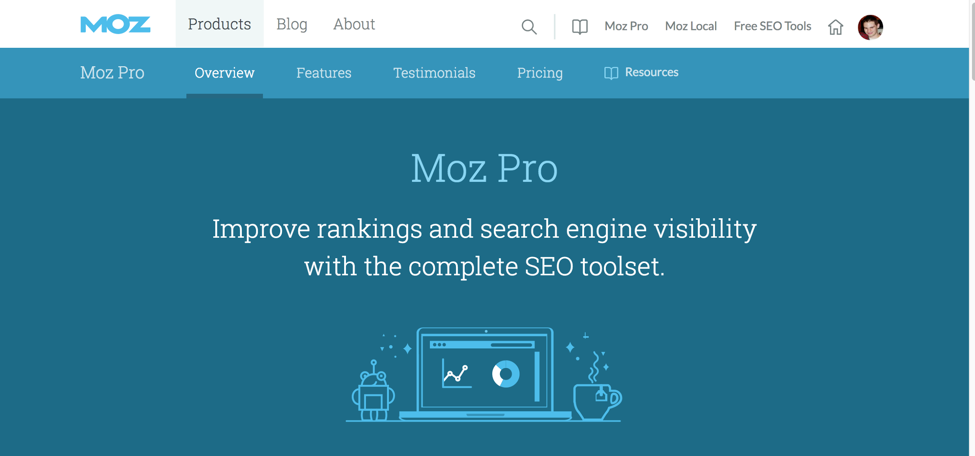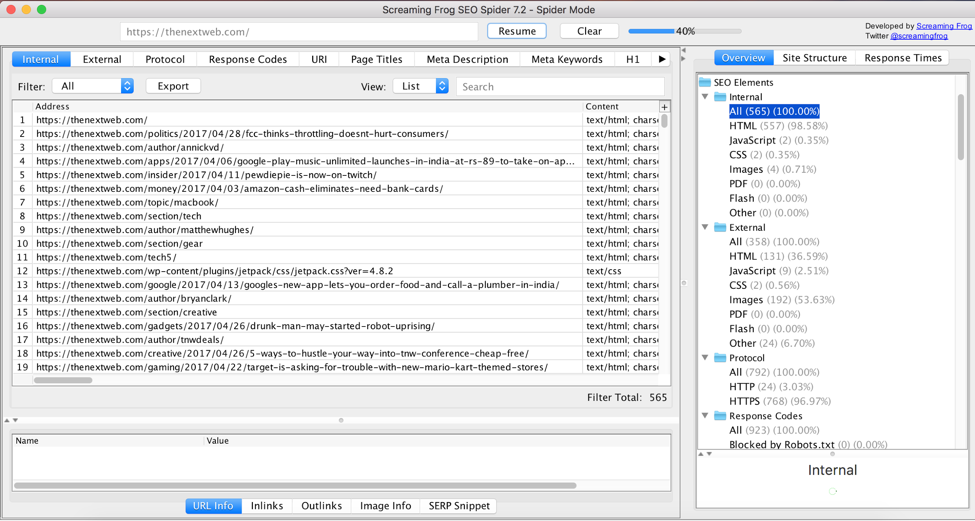Table of Contents
It can be very difficult to know where to begin when starting a new SEO campaign. Sure, you may understand that external links are one of the key components of Google’s algorithm, but is that the thing you should be focused on first?
Any data-driven SEO needs to have a reliable set of tools in order to properly diagnose website issues and find opportunities to improve optimization. As someone who works frequently on SEO campaigns, I thought it would be helpful to share some of the tools that I use every single day. Used in combination, the following tools can be fundamental in guiding your SEO efforts.
Related Content:
1. Chrome DevTools

Primary Function: On-Page SEO
While Chrome Dev Tools doesn’t seem to get as much love as it should in the SEO industry, it is a tool that I use every single day. Using Chrome Dev Tools, you can quickly evaluate the HTML, CSS, JavaScript and other programming languages contained on a page. At the most basic level, this tool is going to allow you to view common on-page elements such as title tags, meta descriptions, H tags, alt text and a variety of other elements. The ability to evaluate these is going to be critical when finding on-page optimization opportunities.
One drawback of many SEO tools is that they might not tell the whole story of what is going on as they may not take into account what is actually rendering in the Document Object Model. SEOs who use Dev Tools are able to view the DOM to see how things such as JavaScript functions could be altering the information on the page. Overall, Chrome Dev Tools is going to give you the most accurate insights as to what is happening when a page loads.
Some other common uses I have found for Dev Tools are:
- Emulating the search results in any geography you wish. This can help give you a better understanding of where you rank when it comes to your Local SEO efforts.
- Using Dev Tools to manipulate the DOM. By doing this, you can test formatting changes to any CSS file to get an understanding of how a website would look without actually having to adjust the code. This is great for quickly testing user experience changes.
- Analyzing the Dev Tools Timeline feature to get detailed insights on page load times.
Required Reading: 6 Things You Should Know About Chrome In Dev Tools
2. Google Search Console
Primary Function: Indexing and Crawling
Google Search Console is one of the most popular tools in most SEO’s arsenal: and for good reason. Search Console offers a lot of diverse data points that are going to assist with everything from penalty removal to backlink analysis. It truly is the swiss army knife of SEO tools.
I find myself relying on Search Console time and time again for larger websites. When sites pass a certain threshold of pages, a good SEO needs to be able to look at the more technical components of the website. This includes looking at things such as crawl budget, page indexation, sitemaps and many other elements that might be impacting Google’s ability to crawl and index large quantities of pages.
Some of my most common uses of Search Console include:
- Analyzing the amount of pages indexed compared to what’s contained in the sitemap. This can help uncover potential issues with crawl budget.
- Defining how Google should handle URL parameters. This is especially useful for eCommerce websites that find URL parameters are getting indexed by Google. Here, you can tell Google not to crawl those pages.
- Researching information in the Search Analytics report for better keyword optimization. In one of my favorite SEO blog posts, Cyrus Shepard talks about how he uses the data he finds in the Search Analytics report to better align a page’s content with the keywords users are searching.
Required Reading: A Beginner’s Guide to Google Search Console
3. Moz Pro
Primary Function: Backlink Analysis
There are so many different features of Moz Pro, that it’s hard to define only one primary purpose for this software. Rank tracking, on-page analysis, keyword research and Local SEO are all areas where Moz has created different tools to assist with SEO campaigns.
One of the most notable tools offered by Moz is their Open Site Explorer which allows users to simply plug in a URL and a get a detailed analysis of links pointing to that page or domain as a whole. More importantly, you can use this tool to find how many links are pointing towards your competitors’ sites to benchmark how many you might need in order to compete in the search results.
On top of this, users can also find metrics such as Domain Authority and Page Authority, which provide a numeric value that assesses the overall SEO health of a domain or page. Although Moz is the only paid tool contained on this list, it comes at an extremely affordable price compared to many SEO software suites and can be used to improve any web property from a local chiropractor to an industrial manufacturer.
Some of my most common uses of Moz are:
- Tracking Domain Authority over time. By recording this every month for your site and competition, you can get an idea of whether or not Google is viewing your website as more authoritative relative to the comeptition.
- Scaling Local SEO efforts with Moz Local. Moz immediately helps correct your website’s citations on some of the most important Web listings including the major data aggregators. Keep in mind this is a separate cost than Moz Pro.
- Performing keyword research with the Keyword Explorer. This tool provides you with other keywords that are tangentially related to your initial query. This is crucial information as Google continues to improve its understanding of entities.
Required Reading: The Moz Pro Guide
4. Screaming Frog
Primary Function: Website Crawler
Personally, I’m a big fan of doing things at scale. This means quickly assessing all of the technical issues of the website as a whole and determining which are most likely to be negatively impacting SEO. Screaming Frog lets me do this and much more.
Screaming Frog is a website crawler that efficiently scans your website’s content and allows you to quickly drill down into the main SEO problems. In one view you can find all of your website’s response codes, pages with un-optimized SEO elements, header directives and much more. It is the ultimate tool for being able to swiftly analyze any major issues with your website.
Some of my most common uses of Screaming Frog are:
- Identifying pages with missing or un-optimized title tags and meta descriptions. These are easy things to find with the tool and do not require much technical knowledge to fix.
- Analyzing the SEO properties of specific sections of a website. Using Screaming Frog “Include” and “Exclude” filters allows you to crawl only the pages that matter most towards your SEO.
- Scraping website anchor text to quickly find internal linking opportunities.
Required Reading: Screaming Frog Guide To Doing Almost Anything
5. Google Analytics
Primary Function: Website Analytics
Although most people may have seen this coming, there is no denying that Google Analytics is the father of all SEO tools. Google Analytics is the most complete website analytics tool out there. Even if you’re a complete SEO novice, simply experimenting with Google Analytics for a couple of hours can bring invaluable insights. Google Analytics will provide you with basic website metrics such as sessions, pageviews, time on site, bounce rate and more. However, there is a huge opportunity to dive even deeper than that.
For instance, by researching within Google Analytics for one of my clients, I noticed that users from a particular browser were registering much higher bounce rates than users from other browsers. This caught me eye, and I dug further and discovered that the client’s website was not rendering correctly when users clicked a search result from this browser. This insight would not have been possible without the help of Google Analytics.
Some of my most common uses of Google Analytics are:
- Segmenting, segmenting and segmenting. If you use Google Analytics for one thing, do this. You can segment your traffic by source, location, device, browser, revenue and just about anything you can think of. Doing this will lead to powerful insights.
- Measuring both website macro and micro conversions. If you know what actions you want your users to take, it’s crucial to understand how to use Google Analytics Goals to measure those actions. For more complicated conversion measurements, you can use Google Tag Manager to record Events such as button clicks.
- Discovering average competitor traffic using the Benchmark reports.
Required Reading: The Google Analytics Academy
While no single tool is going to give you all the data you need, in conjunction the 5 tools above are going to give you a fantastic idea of where you should focus your SEO efforts. While Moz may inform you that you have plenty of backlinks, Search Console might reveal that many of your pages are not indexing properly. As your knowledge of these tools improves, so does your effectiveness at implementing successful SEO campaigns.
Search News Straight To Your Inbox
*Required
Join thousands of marketers to get the best search news in under 5 minutes. Get resources, tips and more with The Splash newsletter:



